Your Basket is currently empty!
How to Make the Perfect mica and Metallic Nail polishes.
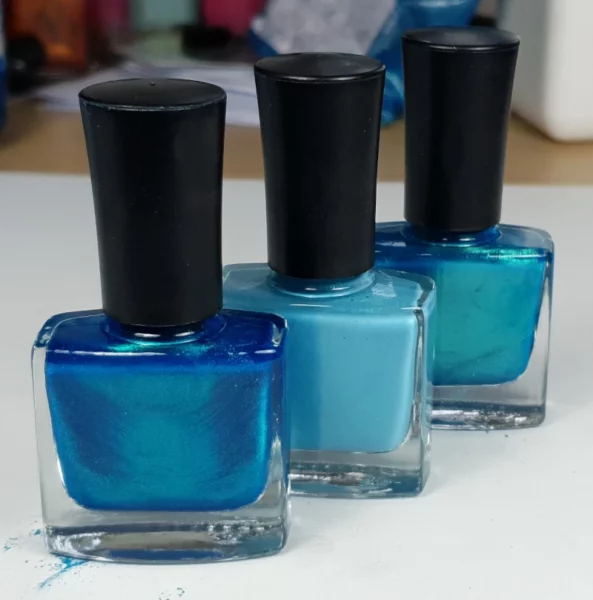
Metallic, shimmery and mica nail polishes are still a big favourite amongst nail polish lovers. However making them can pose some challenges.
I am going to explain three different methods for making metallic nail polishes with mica powder and outline the main advantages and disadvantages of all three methods.
Nail polishes made with mica powder alone tend to very be sheer and transparent.
This is because the mica pigment used to make these nail varnishes have very small particle sizes which add lots of shimmer but do not provide much coverage on the nail.
For some wearers this is not a problem, however some of us like our nail polishes to be quite opaque and solid finish.
To get the best of both worlds – which is a nice strong shimmer and a more opaque appearance – you can use both nail polish liquid pigments and mica powder together.
The mica powder provides the shimmer and some colour and the liquid pigments provide colour and opacity.
Method 1 – No liquid pigments. Just mica powder
To make a metallic, mica nail polish just with mica is very simple. You simply add some mica powder to a pearl nail polish suspension base such as High Gloss Pearl nail polish suspension base and mix it thoroughly.
The important thing to remember is not to add too much mica powder. Too much mica powder will prevent your nail polish from sticking to your nail and may lead to premature chipping.
If your nail polish just falls off your customers nail two minutes after it’s applied your customer won’t be impressed no matter how much expensive mica you added.
As a general rule do not use more than 10% mica powder in your nail polish formulation. So if you are making a 10ml bottle of nail polish then add up to about 1ml of mica.
You might be wondering “1ml of mica…but mica is a powder not a liquid…how can I add 1.5ml of mica?…”
The best way to create your test batches is to use measuring spoons or scoops to measure your mica powders. We stock 0.5ml scoops.
So 2x 0.5ml is 1ml. Use a maximum of 10% and no more!
The nail polish below contains 1ml (2 x 0.5ml scoops of Hummingbird Blue mica powder).
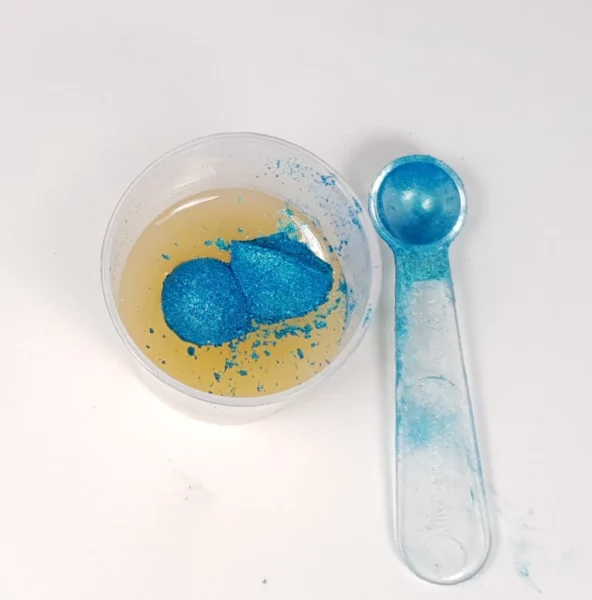

Advantages –
Using only mica powder means that your polish will have maximum shimmer and shine.
When you add liquid pigments to your nail polish along with mica powder the liquid pigments act like paint which partially covers over your mica powder making it less sparkly.
Think of it like this. If you put some shiny stones in a gold fish bowl and the water is nice and clear, you will see the shiny stones very clearly. However if you were to add some milk to the water then it would become cloudy and make your shiny stones harder to see.
The same happens when you add liquid pigments along with mica to your nail varnish. Depending on how much liquid pigment you add you are making it that much harder for your shiny mica powder to be seen in your polish.
So by only using mica you will get the full sparkly effects of the mica pigments without any liquid pigment getting in the way.
Disadvantages
The main disadvantage of using only mica powders to make a metallic shimmery polish is opacity. Mica powders do not have great coverage capacity especially at the usage rates for nail polish.
If you were to add the amount of mica to your nail polish that is required to achieve full opacity in the finished product, your nail polish would be useless.
So you generally won’t get an opaque finish if you use only mica powders to colour your nail polish.
Method 2 – Liquid pigment and Mica Powders
Okay so we know that using mica powder alone gives us the best chance to show off our shiny micas.
But what if you want a bit more depth and opacity to your finished polish? Well you can add some liquid pigments.
Now most liquid pigments are made with lakes and dyes. A smaller percentage are made with oxides. Oxides tend to have more opacity that lakes and dyes.
When I think of liquid pigments made with lakes and dyes I think of them as water with food colouring in it. When you put food colouring in water you can still see right through it.
It might look like green or blue water but it is still very transparent. But adding oxides to your polish, especially titanium dioxide is like adding milk to water. The water just gets so cloudy that you can hardly see anything through it.
So when you are making a metallic polish with mica and liquid pigments try to stick to the liquid pigments except White and Iron Oxide liquid. Most of the other liquid pigments use dyes and lakes as their colouring agents.
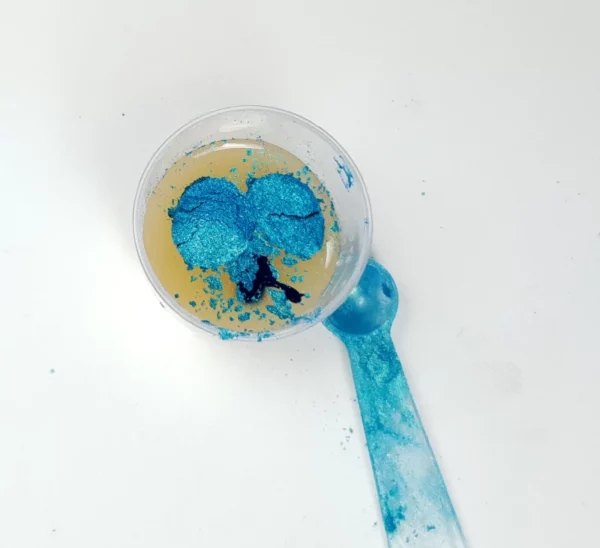
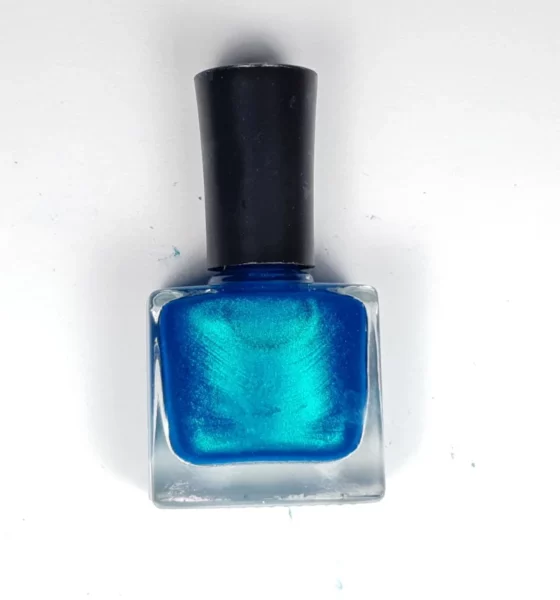
The nail polish above contains 1ml (2x 0.5ml scoops) of Hummingbird Blue mica powder and 0.5ml of Marine Blue liquid pigment.
The liquid pigment has actually enhanced the shimmery effect by adding a darker contrast to the Hummingbird Blue mica powder.
Because the marine liquid pigment is not oxide based it does not cover over the mica powder and prevent it from being seen through the nail polish.
Advantages
You can have the metallic effect and a more opaque solid finish to your nail polishes.
You can also create two tone nail polishes. If your nail polish is coloured red with liquid pigment you can add gold mica to it and still see some of the gold effects from the mica. So you end up with a red/gold nail polish.
Disadvantages
You must not add too much liquid pigment and mica because it will affect how well your nail polish sticks to the nail and it may make it chip more easily so try not to use more than 15% liquid pigment and mica combined.
Method 3 – Oxide Based Liquid Pigment
Now this is where it gets trickier. Remember what I said before about the liquid pigment causing the same effect as milk? Well titanium dioxide is exactly like that.
Titanium dioxide is a white pigment used a lot in paint manufacture because it is so good at covering things up.
The problem with adding it to nail polishes where you also want to have a shimmery effect is that titanium dioxide will just cover over your mica powder.
It will become very difficult to see any shimmery effects at all. The same also applies to a lesser extent to other oxides such as red iron oxide and black iron oxide.
So if you want to add oxide based liquid pigments to your mica and metallic nail polishes you’ll want to add much less of those compared to the dye and lake based liquid pigments.
The nail polish below contains 1 ml (2 x 0.5ml) of Hummingbird Blue mica powder and 0.3ml of white liquid pigment. It is very hard to see any shimmery effects at all!
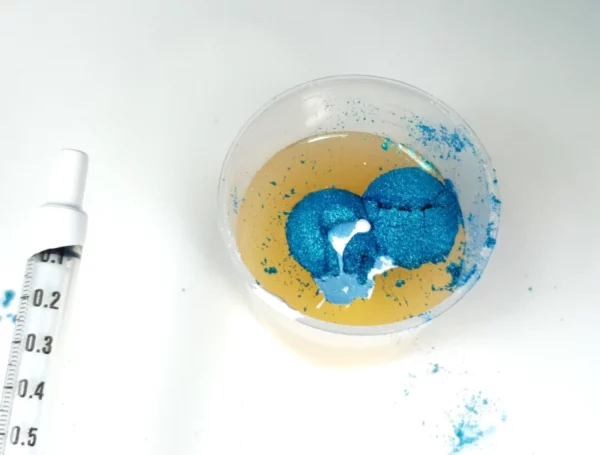
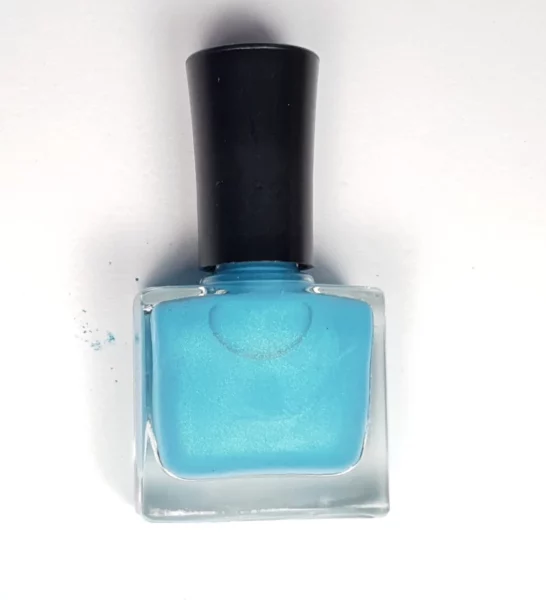
Advantages
Adding oxides will give your nail polish much more opacity and better coverage.
Disadvantages
If you add too much the oxides will cover over your mica colours and reduce their shimmery effects.
Titanium dioxide and black iron oxide can significantly lighten or darken your nail polish. So if you add titanium dioxide to blue it will make the colour a pastel blue as shown above.
So you must decide what you want to final colour of your nail polish to be and match the micas and liquid pigments accordingly.
It can take some time to create the polish that you have in mind but experimentation is your friend. Keep trying different liquid pigments and mica powders until you create the nail polish that you want.
Thanks again for tuning in. Please leave a comment below if you found this helpful or any other comments. We would love to hear from you. 🙂

Wow this is so incredibly helpful, thank you SO much!! I’ve been making my own polish for a couple of weeks basically stumbling through it because there is such little information online about making polish!
Thank you for the feedback. So glad that you found it helpful. It can be quite tough in the beginning when you are starting to make nail polish. And yes you are right, there is little information out there about making it. Is there anything else that you would like some pointers/info on?
I have SO many questions! But don’t feel obligated to answer all of them or feel free to use them to write additional articles :).
What is stamping polish?
What ingredient gives nail polish a “frosty” look?
What are “matte” pigments/dyes that I’ve seen on various websites to purchase? I understand the concept of matte but how is the pigment/dye different from other types? Do they make nail polish more opaque if you add it?
What ingredient do they have that causes them to be matte?
How do you make a concentrated liquid pigment? Is it just suspension base and a bunch of dye or oxide? Should the amount of liquid ingredients that you use when making polish change depending on how concentrated your liquid pigment is? For example, I might use a liquid pigment that has a lot more dye in it than another one. Would I need to use less of it on my polish to make sure it doesn’t chip or become brittle?
If I want to lighten up a mica (not lighten to a pastel) but I don’t want it to become opaque by using white pigment or titanium dioxide, is it possible or do you just have to get a different mica that is lighter in color?
Thank you for your suggestions. They will be great for some articles that would be really helpful. We will look into this and see what we can do God willing. Thanks Taylor.